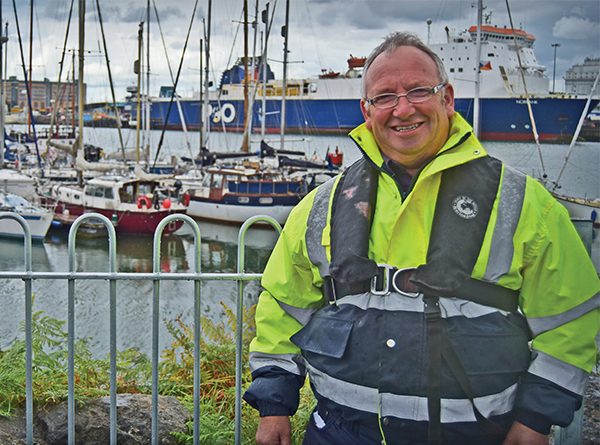
Above: Jimmy Murray at Cargo Maritime Village.
Photo by Kevin O’Gorman.
The Irish Nautical Trust is currently re-establishing plans to provide a purpose-built Enterprise and Training facility in the Docklands area. It is envisioned that the proposal will be included in any future development being planned for the Plot 8 site on the Grand Canal Basin.
The training facility, which would be called Cargo Maritime Village, would provide a full and comprehensive certified training programme for local unemployed and disadvantaged people and create opportunities leading to sustainable employment within the maritime sector and local indigenous businesses.
The need for the proposed training facility is supported by the findings of an expert group on Future Skill Needs Study, carried out by the Department of Jobs, Enterprise and Innovation in April 2015, which found that there will a growing demand for skilled labour in the marine industry and related maritime sectors in the coming years.
The initiative is the brainchild of Jimmy Murray (CEO), a man infused with enthusiasm for the maritime industry and the traditions it represents. A Ringsend native, he has been around boats and the river all his life. He is well placed to understand the needs of the riverside communities which have traditionally been dependent on maritime occupations and the changing needs of the industry.
Jimmy told NewsFour, “Since the beginning of time, ships have been tied with ropes and that won’t change. The maritime sector will always need workers. What has changed is the nature of the work.
Containerisation reduced the need for manual labour and increased the need for skilled workers. Before containerisation everything had to be manually handled: unloading, cargo handling, cleaning, cranes and shovels. Today, the work of 30 men has been reduced to about seven or eight in these areas.
At one time there were up to 4,000 dockers working in Dublin Port, in casual employment. That number has been reduced to about 900. There is a need now for more skilled workers such as Radio Communication/Traffic Controllers, Pilot Boat Operatives, Tugboat Operatives and Marine Operatives.
Learning on the job and working your way up has been replaced by training, and workers now need tickets and licences to operate machinery and to work in the Port. For example, you now need a Skippers Ticket to handle small boats, such as Tugs and Pilot Boats.”
He went on to say “It is important that potential trainees are brought onboard working vessels and into the port environment to introduce them to a wide range of maritime activities to see how the sector works and to find their niche.”
Potential trainees will come from local Community Training Projects. Many of them will have had fathers and grandfathers who worked on the Docks.
The training programme will introduce students to the sector and bring in professionals to give them the skills they need to work in the Maritime sector today. After the initial training period, the training facility will help students link with colleges that provide further education and help them find work throughout their careers.
The Trust has already identified a number of possible future employment opportunities for people with the right qualifications in the marine sector and the marine services sector and will continue to communicate with all the maritime companies who operate out of Dublin Port to understand their growing needs.
On December 23rd, 2015 representatives from the Trust met with the relevant NAMA personnel looking after the Plot 8 Site, who confirmed that the initial commitment made by the DDDA and Waterways Ireland to include the INT in any future development being planned for the site still stands.
In the meantime INT have submitted a proposal to DCC to use one of the Old Liffey Ferries (No.11) as the first training vessel for the programme.
Jimmy told NewsFour, “The ferry looked after the fathers and grandfathers of many of the young people who will take the courses, bringing them to and from their homes along the riverside to the Docks. In the future it will serve the people of Dublin as a transport option and provide an ideal training environment for the people of Ringsend, Irishtown, East Wall and Sheriff Street. It will once again link these communities. It has a great history and a great future.”
He went on to say, “Dublin Port and DCC are considering the proposal for the ferry to be used for its original purpose and also to act as the first flagship for the INT Training Programme for the youth of the area.”
INT have a proven track record of facilitating young people with training and finding work. Before the decline in the economy and the demise of the DDDA they helped implement training for unemployed young people in the area through local Community Youth Training Programmes. Additionally, they supported a number of very successful local businesses such as Surf Dock, Viking Splash and Sea Shore and Safety. They will work in partnership with DCC and Dublin Port to agree criteria for the proposed Training Programme.
For Jimmy, Cargo Maritime Village is a labour of love. The river has been good to him, providing him with a decent living throughout his life. He also gets great pleasure from his activities on the water. He loves boating and fishing and is a member of the Poolbeg Yacht Club and the Ringsend Registered Fishermen & Private Boat Owners Association. He wants to bring his love of the Liffey to the young people who live by the river. He tells NewsFour, “I want them to experience it, love it and make a living from it like their fathers and grandfathers.”
By Jennifer Reddin



